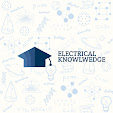COULOMB'S LAW
COULOMB'S LAW
COULOMB'S LAW
Coulomb confirmed that the electric force between two small charged spheres is proportional to the inverse square of their separation distance r. The operating principle of the torsion balance is the same as that of the apparatus used by Cavendish to measure the gravitational constant, with the electrically neutral spheres replaced by charged ones. The electric force between charged spheres A and B causes the spheres to either attract or repel each other, and the resulting motion causes the suspended fiber to twist. Because the restoring torque of the twisted fiber is proportional to the angle through which the fiber rotates, a measurement of this angle provides a quantitative measure of the electric force of attraction or repulsion. Once the spheres are charged by rubbing, the electric force between them is very large compared with the gravitational attraction, and so the gravitational force can be neglected.
Coulomb’s experiments showed that the electric force between two stationary charged particles
• is inversely proportional to the square of
the separation r between the particles and directed along the line joining them
• is proportional to the product of the
charges q1 and q2 on the two particles;
• is attractive if the charges are of opposite
sign and repulsive if the charges have the same sign.
From these observations, we can express Coulomb’s law as an equation giving the magnitude of the electric force (sometimes called the Coulomb force) between two-point charges:
where ke is a
constant called the Coulomb constant. In his experiments, Coulomb was able to
show that the value of the exponent of r was 2 to within an uncertainty of a
few percent. Modern experiments have shown that the exponent is 2 to within an
uncertainty of a few parts in 10 to the power 16.
The value of the
Coulomb constant depends on the choice of units. The SI unit of charge is the
coulomb (C). The Coulomb constant ke in SI units has the value.
This constant is also written in the form
The smallest unit of charge known in nature is
the charge on an electron or proton,1 which has an absolute value of
Therefore, 1 C of
charge is approximately equal to the charge of 6.24 * 10 to power18 electrons
or protons. This number is very small when compared with the number of free
electrons2 in 1 cm3 of copper, which is of the order of 10 TO POWER 23. Still,
1 C is a substantial amount of charge. In typical experiments in which a rubber
or glass rod is charged by friction, a net charge of the order of 106 C is
obtained. In other words, only a very small fraction of the total available
charge is transferred between the rod and the rubbing material.
When dealing with
Coulomb’s law, you must remember that force is a vector quantity and must be
treated accordingly. Thus, the law expressed in vector form for the electric
force exerted by a charge q 1 on a second charge q2, written F12, is
where r is a unit
vector directed from q1 to q2. Because the electric force obeys Newton’s third
law, the electric force exerted by q2 on q1 is equal in magnitude to the force
exerted by q1 on q2 and in the opposite direction; that is, F21 = -F12.
Finally, we see that if q1 and q2 have the same sign, the product q1q2 is
positive and the force is repulsive. If q1 and q2 are of opposite signs, the
product q1q2 is negative and the force is attractive. Noting the sign of the
product q1q2 is an easy way of determining the direction of forces acting on
the charges.






No comments:
If you have any doubts, please let me know